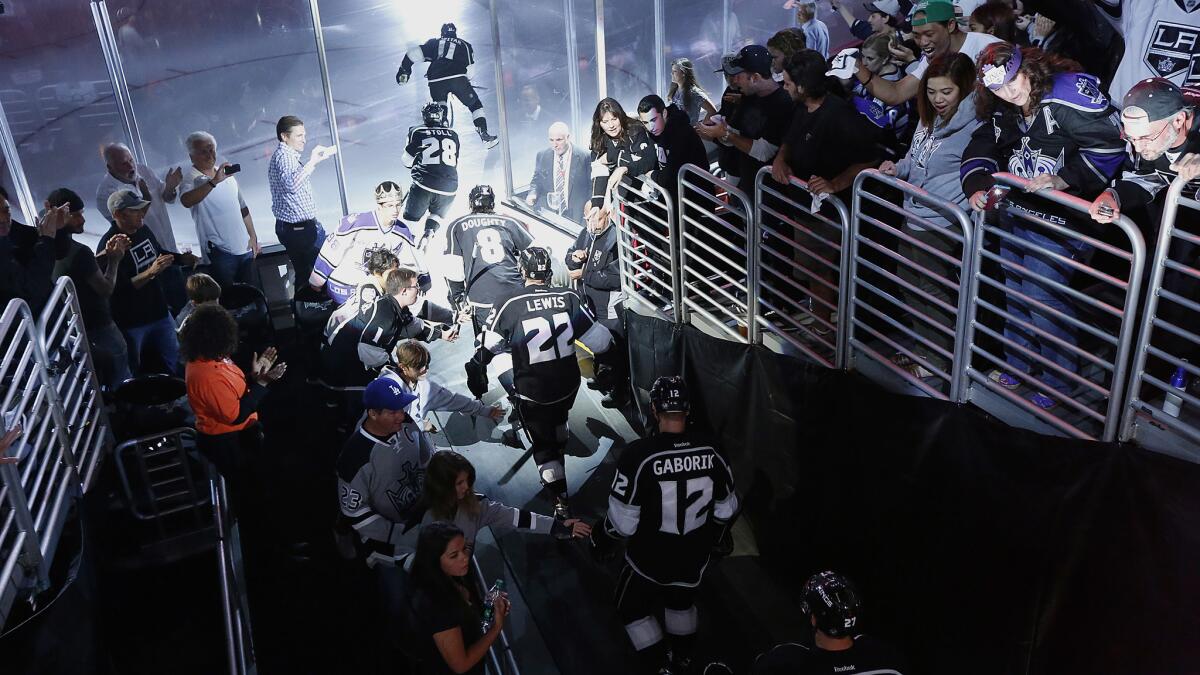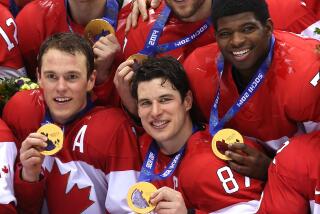Column: Hockey neophytes, here’s where you come to terms with the sport

In person, hockey has always been the most exciting pro sport. On TV, it’s finding a new audience, thanks to high-def big screens that allow viewers to actually see the puck.
NBC Sports reports that the first two rounds of the playoffs were the most watched in cable history, up almost 20% over last year.
But a Stanley Cup Final attracts an even bigger audience, drawing new fans puzzled by the odd jargon and terminology of a sport they’re still learning.
Hockey games raise many questions for these newcomers, who are hesitant to ask their beered-up, know-it-all friends. For them, we offer Hockey 101, a master’s level contemplation of a bruising and glorious sport.
Please silence your cellphones.
Question: What’s the neutral zone?
The area in the middle, between the Blue Lines.
Q: What’s the Blue Line?
Separates neutral zone from attacking zone. Also, the only way to get to Long Beach during rush hour.
Q: What’s the Red Line?
Running through Hollywood, the Red Line is what you take if you’re going to a play at the Pantages. In hockey, it’s the 50-yard-line.
Q: Where’s the three-point line?
The NHL has yet to adopt a three-point line. But there is a jail.
Q: Why’s there a jail?
Also called a penalty box, the jail is where players go when they misbehave.
Q: Why do players misbehave?
Why do babies cry? Why do starlets drink?
Q: Why do hockey fans drink?
Among fans, beer is renowned for stimulating clear thinking and kind thoughts. What bananas are to monkeys, what absinthe is to France, beer is to hockey. In hockey, every game celebrates the end of Prohibition and major wars.
Q: What’s this thing called icing?
Icing is the best part of a cupcake. It’s also the state flower of North Dakota. In hockey, it refers to flinging the puck from your own half of the ice past the opposing goal line, a penalty unless you’re on the short end of a power play, in which it is all right and considered good hockey. Infractions do not require jail time. There’s a whistle, then some sort of resolution, often known as a faceoff.
Q: What’s a faceoff?
Hockey’s version of a divorce settlement, but with less long-term debt.
Q: What’s a puck?
That little black coaster-looking thingy that everyone chases.
Q: What’s charging?
Morally reprehensible full-frontal assault in an attempt to get the puck. Illegal yet often cheered.
Q: What’s hooking?
Under the NHL’s Rule 55, hooking is using the stick to impede your opponent (legal in some parts of Nevada).
Q: What language does Kings Coach Darryl Sutter speak?
A Canadian farmer’s version of English. Idiomatic, yet mordantly entertaining. Most sentences begin and end with the word “Yup.”
Q: Is Sutter the tannest man in sports?
Yup.
Q: How can this be?
Yup.
Q: Who exactly is Stanley and what’s with this big silver cup?
Lord Stanley of Preston is the founding father of the game of hockey. He commemorated success with the world’s biggest beer stein, which became known as the Stanley Cup.
Q: What’s a power play?
It’s what billionaires do to impress friends.
Q: Does this work out for them?
Almost always.
Q: In hockey, what’s a power play?
It refers to a manpower advantage during a penalty, usually after an assault (see jail above).
Q: What’s high sticking?
High sticking is when you flail your hockey stick over your opponent, accidentally or otherwise, to guillotine his head from its chassis. Severity of penalty depends on blood flow (really).
Q: How long will this series last?
Long drawn-out spectacles are an L.A. tradition. There’s the Oscars, of course, and Lindsay Lohan’s troubled adolescence (now in its 24th year). Then there are these NHL playoffs. I forget when they started, but I think we had a Republican president. Might’ve been Harding.
More to Read
Go beyond the scoreboard
Get the latest on L.A.'s teams in the daily Sports Report newsletter.
You may occasionally receive promotional content from the Los Angeles Times.







